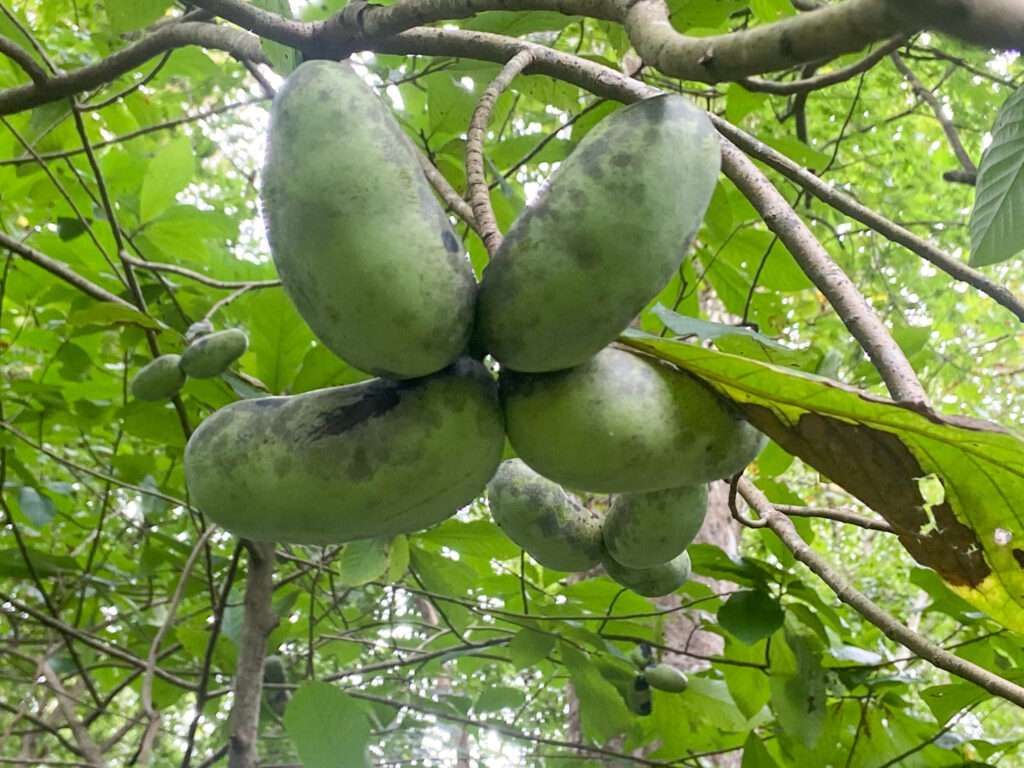Many people have heard about a pawpaw patch in a song, but don’t realize that there is such a place. Pawpaw (Asimina triloba) is a tropical to subtropical shrub or small tree in the custard apple family. It was first observed by Hernando DeSoto in 1541, but Native Americans had been consuming the fruit and using the plant for millennia. The fibrous bark was used by the Catawba Indians to make cordage for nets. The name comes from papaya, although the plants are not closely related. The genus Asimina comes from the Potawatomi Indian word for the plant “asimen.”
The large seeds of pawpaw will not pass through the digestive tract of existing mammals except large animals such as deer and bear. It is believed that the large fruit and seeds evolved to be dispersed by extinct megafauna such as sloths and mastodons. It is likely that Indigenous people also helped disperse the seeds by collecting and moving fruit and, in some cases, growing pawpaw near their towns.
Pawpaw is usually less than 20 feet tall but can reach heights of 40 feet with a 10-inch diameter. However, it often is a multistemmed shrub rather than a tree. It prefers moist but not saturated sites in shade or partial sun and does well as an understory plant. It produces root suckers, so a patch of pawpaw can actually be the same tree with the many stems connected underground.

The alternate simple leaves are up to a foot long and 4 inches wide, with a blunt tip and wedge-shaped base. The twigs and bottom of young leaves are covered by rusty hairs that fall off with time. The buds are covered with rusty hairs and lack protective scales, so the primordial leaves can be seen with the naked eye in the winter. The leaves and other plant parts have a pungent odor reminiscent of diesel fuel. The odor is due to a chemical cocktail that protects the plant from predators. Few insects and no mammals will consume the plant except for the ripe fruit. Some of the chemical compounds are being studied for use as insecticides and to treat cancer. The zebra swallowtail (Eurytides marcellus) and pawpaw sphinx moth (Dolba hyloeus) larvae feed primarily on pawpaw leaves. The zebra swallowtail sequesters the toxins into its body, so it is distasteful to predators.
The purple downward-facing flower is cup-shaped and forms in leaf axils in the spring before leaf expansion. The 1.5- to 2-inch-wide flower has two whorls of three petals. Most dicots have petals in whorls of four or five, but pawpaw breaks the rules and has whorls of three, which is more like a monocot. Pawpaws are ancient and primarily pollinated by beetles and flies. They evolved flowers before bees were common and provided pollinator food from structures at the base of the petals for beetles and flies. The flowers attract pollinators with red to purple flowers resembling rotting flesh and a fetid odor. The flower produces its own heat to volatilize the odor. Think about that. The plant produces its own heat. Only animals are supposed to do that. Even stranger, the flowers can change sex. They begin as females and then transition to males. The heat-producing flower petals provide a place for the pollinators to spend the night on cool spring days. The flowers do not close at sunset, but the petals curve over the flower center, creating pollination chambers for the beetles to reside while they dine on the petals. It is like a beetle bed and breakfast on a branch. Beetles and flies are not the most reliable pollinators, so this strategy encourages them to spend more time in the flower.

The 6-inch-long and 1.5-inch-wide fruit is the largest fruit in North America and has seeds up to 0.75 inches in width. The fruit is yellow to brown when ripe, but often falls from the tree while still green. The skin and seeds are toxic, with the skin sometimes causing dermatitis. Once the sweet fruit is ripe, it is only good for two to three days. It is consumed by many animals, including fox, opossum, and raccoon. You need to collect them as soon as they drop to outcompete the animals. Eat them when they turn yellow to brown. The mineral-rich flesh is high in vitamin C and has a flavor similar to bananas or custard. Some people get an upset stomach from the flesh, so only small amounts should be consumed. The fruit can be used to make ice cream and other treats, and was used by Native Americans to make bread or dried for winter consumption. There is currently research to develop pawpaw into a commercially viable fruit. If you really want to experience pawpaw fruit, attend the Pawpaw Festival in Taylors, SC, at the end of August.
Sources and further reading
https://www.missouribotanicalgarden.org/plantfinder/PlantFinderDetails.aspx?taxonid=275970
https://www.clemson.edu/cafls/demo/plant_profiles/asimina-triloba.html
https://plants.usda.gov/DocumentLibrary/plantguide/pdf/cs_astr.pdf
https://www.wildflower.org/plants/result.php?id_plant=astr
https://www.illinoiswildflowers.info/trees/plants/pawpaw.htm
https://www.torreyaguardians.org/pawpaw-ecological-michigan.html
Author(s)
Robert Carter, Cooperative Extension, Forestry and Wildlife Agent
Clemson University Cooperative Extension Service offers its programs to people of all ages, regardless of race, color, gender, religion, national origin, disability, political beliefs, sexual orientation, gender identity, marital or family status and is an equal opportunity employer.
